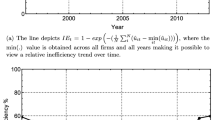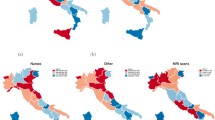Abstract
A sizable literature related to the efficiency of the U.S. hospital sector has been produced over the past 30 years. Much of this research is based on stochastic frontier analysis. This approach is problematic for a number of reasons. For one, a functional form for a hospital’s cost function must be assumed, and a limited number of forms are tractable. Second, inefficiency is measured as the expectation of a random variable with a pre-determined distribution, with no theoretical justification for the underlying assumption, that observed cost equals minimum cost plus some non-negative, random amount. Thus, the conclusion reached by most of these studies, that U.S. hospitals are inefficient, may not be foregone. Using an entirely different methodology that obviates these shortcomings, the current study suggests that whether or not hospitals are efficient, their revenues have not been increasing in proportion to the minimum cost of providing their services. This study’s estimates of the impact of input prices and technology on production costs indicate that between 2000 and 2017, hospital revenues increased at a substantially higher rate than hospital costs. This study suggests that hospitals are pricing their services well above average cost. As a result, in 2017 over $200 billion could have been transferred from patients to the hospital sector, whether due to the proclivity of hospital administrators to purchase more inputs than are necessary for production, or to subsidize activities other than patient care.
Similar content being viewed by others
Notes
Stochastic frontier analysis has almost always led to the conclusion that hospitals are inefficient. However, as Newhouse (1994, p. 320) pointed out: “Strong and non-testable assumptions must be made to obtain results with these methods.” See Mutter et al. (2011) for a more recent discussion of the limitations of these two methodologies.
The most commonly used datum for the cost incurred by a U.S. hospital comes from cost reports filed with Medicare, the medical insurance provided to elderly U.S. residents by the federal government of the United States.
These percentages do not add to 1 since there are a number of categories of spending on the 990 Form in addition to these six (e.g., spending on lobbying, advertising, travel, and conference attendance).
The Bureau of Labor Statistics industry code is 622000; the occupation codes are, respectively, 29–1060, 29–1141, 29–0000, 31–0000, 43–0000, 13–0000, 11–0000, 35–0000, 37–0000.
The weights were, respectively, 0.0107, 0.259, 0.2367, 0.1272, 0.1514, 0.0171, 0.0386, 0.0298, 0.0393.
See Table 1.1.4, Bureau of Economic Analysis (2021b). For 2000, 2009, and 2017 the index values for structures were 55.283, 92.613, and 112.668, respectively. The values for equipment were 114.224, 103.169, and 97.565, respectively. As a check, the indexes of five types of equipment were examined: air conditioning and refrigeration equipment (1148), electronic computers & computer equipment (115), x-ray & electro-medical equipment (1179–05), office machinery & parts (1193–07), and surgical & medical instruments (1562) (Bureau of Labor Statistics 2017a, 2009a, 2000, Table 6 in the 2000 and 2009 issues, and Table 9 in the 2017 issue). The averages of the percentage changes in these indexes were negative for both periods and comparable to the percentages changes in the Bureau of Economic Analysis (2021b) index for equipment. The percentage change in the prices of supplies was based on producer price index industry data for general medical and surgical hospitals.
In 2000, the current cost of the net stock of equipment owned by hospitals was $82.2 billion. The value of hospital structures was $336.8 billion. Thus, the weights for structures and equipment were 0.8038 and 0.1962.
Technically, a change in the product mix would affect cost shares. If the shares of higher priced inputs (e.g., doctors) increased due to a change in the mix, the increase in costs over time would be greater than otherwise.
The number of injury-related visits to emergency rooms fell from 31.7 million in 2006 to 30.4 million in 2013 (U.S. Department of Health and Human Services 2016, Table 75, p. 284).
Some of the difference between revenues and input costs finances charity care from hospitals. Whether or not this is the most efficient way of providing hospital care to those unable to pay for that care is beyond the scope of this study.
References
Aigner, D., Lovell, C., & Schmidt, P. (1977). Formulation and estimation of stochastic frontier production function models. Journal of Econometrics, 6(1), 21–37.
American Hospital Association. (2016). Trendwatch Chartbook 2016. Retrieved May 10, 2020 from: https://www.aha.org/system/files/2018-01/2016-chartbook.pdf
American Hospital Association. (2019). Trendwatch Chartbook 2019. Retrieved May 10, 2020 from: https://www.aha.org/system/files/media/file/2019/11/TrendwatchChartbook-2019-Appendices.pdf
American Hospital Directory. (2021). Individual hospital statistics for Michigan. Retrieved May 20, 2020 from: https://www.ahd.com/states/hospital_MI.html
Bureau of Economic Analysis (2021a). Fixed Assets Accounts Tables: Private Fixed Assets by Industry: Retrieved July 7, 2021 from: https://apps.bea.gov/iTable/iTable.cfm?ReqID=10&step=2
Bureau of Economic Analysis. (2021b). National Income and Product Accounts: Domestic Product and Income. Retrieved July 10, 2021 from: https://apps.bea.gov/iTable/iTable.cfm?reqid=19&step=2#reqid=19&step=2&isuri=1&1921=survey
Bureau of Labor Statistics. (2000). PPI Detailed Report: Data for June. Retrieved July 7, 2021 from: https://www.bls.gov/ppi/detailed-report/ppi-detailed-report-june-2000.pdf
Bureau of Labor Statistics. (2009a). PPI Detailed Report: Data for June. Retrieved July 7, 2021 from: https://www.bls.gov/ppi/detailed-report/ppi-detailed-report-june-2009.pdf
Bureau of Labor Statistics. (2009b). Occupational employment and wage statistics: national industry-specific and by ownership. Retrieved July 10, 2021 from: https://www.bls.gov/oes/tables.htm
Bureau of Labor Statistics. (2017a). PPI Detailed Report: Data for June. Retrieved July 7, 2021 from: https://www.bls.gov/ppi/detailed-report/ppi-detailed-report-june-2017.pdf
Bureau of Labor Statistics. (2017b). Occupational employment and wage statistics: National industry-specific and by ownership. Retrieved July 10, 2021 from https://www.bls.gov/oes/tables.htm
Hollingsworth, B. (2008). The measurement of efficiency and productivity of health care delivery. Health Economics, 17(10), 1107–1128.
Massachusetts Hospital Association. (2010). Hospital Costs in Context: A Transparent View of the Cost of Care. Retrieved May 2, 2020 from: https://docuri.com/download/hospital_59c1e9c2f581710b286d60a6_pdf
Mutter, R., & Rosko, M. (2014). The association of hospital cost-inefficiency with certificate-of-need regulation. Medical Care Research and Review, 71(3), 280–298.
Mutter, R., Rosko, M., Greene, W., & Wilson, P. (2011). Translating frontiers into practice: Taking the next steps towards improving hospital efficiency. Medical Care Research and Review, 68(1), 3S–19S.
Newhouse, J. (1994). Frontier estimation: How useful a tool for health economics? Journal of Health Economics, 13(3), 317–322.
ProPublica. (2021). Nonprofit explorer. Retrieved July 1, 2021 from: https://projects.propublica.org/nonprofits/search?utf8=%E2%9C%93&q=hospital&state%5Bid%5D=MI&ntee%5Bid%5D=&c_code%5Bid%5D=
Rosko, M., & Mutter, R. (2008). Stochastic frontier analysis of hospital inefficiency: A review of empirical issues and an assessment of robustness. Medical Care Research and Review, 65(4), 131–166.
Rosko, M. (2001). Cost efficiency of U.S. hospitals: A stochastic frontier approach. Health Economics, 10(6), 539–551.
St. Louis Federal Reserve Bank. (2021). Moody's seasoned AAA corporate bond yield. Retrieved July 10, 2021 from: https://fred.stlouisfed.org/series/AAA
U.S. Department of Health and Human Services. (2018). Health, United States, 2018. Retrieved June 30, 2021 from: https://www.cdc.gov/nchs/data/hus/hus18.pdf
U.S. Department of Health and Human Services. (2016). Health, United States, 2016. Retrieved June 30 from: https://www.cdc.gov/nchs/data/hus/hus16.pdf
Vaudrey, B., & Loos, S. (2013). Compensation 2013: Evolving models, emerging approaches. Group Practice Journal, 15(2013), 8–15.
Vitaliano, D., & Toren, M. (1996). Health cost and efficiency in a regime of stringent regulation. Eastern Economic Journal, 22(2), 161–175.
Zuckerman, S., Hadley, J., & Iezzoni, L. (1994). Measuring hospital efficiency with frontier cost functions. Journal of Health Economics, 13(3), 255–280.
Acknowledgements
We are extremely grateful to an anonymous referee for their comments and suggestions, particularly so for their diligence in checking our calculations.
Author information
Authors and Affiliations
Corresponding author
Ethics declarations
Declarations of Interests
None.
Additional information
Publisher’s Note
Springer Nature remains neutral with regard to jurisdictional claims in published maps and institutional affiliations.
Rights and permissions
About this article
Cite this article
Alexander, D., Neill, J. Inefficient or Not, Hospitals Are Overcharging. Int Adv Econ Res 27, 273–286 (2021). https://doi.org/10.1007/s11294-022-09840-z
Accepted:
Published:
Issue Date:
DOI: https://doi.org/10.1007/s11294-022-09840-z




